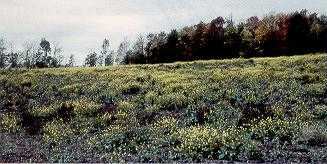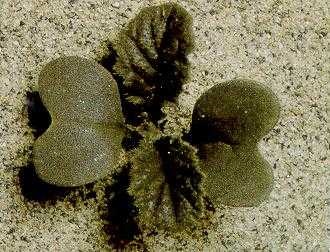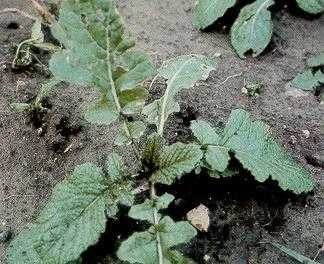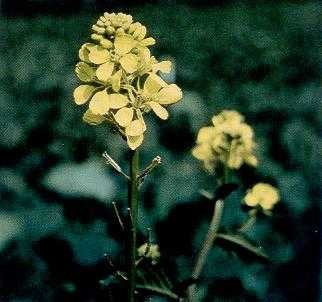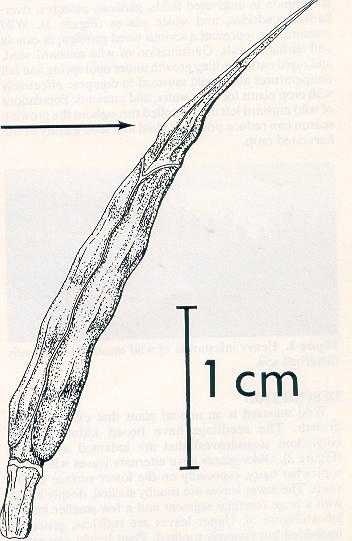Wild mustard
Learn how to identify wild mustard and control options.
ISSN 1198-712X, Published April 2003
Introduction
Wild Mustard (Sinapis arvensis L., Brassica kaber (DC.) L.C. Wheeler var. pinnatifida (Stokes) L.C. Wheeler) is an aggressive weed indigenous throughout most of the temperate regions of Europe, Asia minor, southwest Asia and North Africa. It was introduced into North America and now occurs throughout all Canadian provinces, as well as in the MacKenzie District, Northwest Territories.
In Ontario, wild mustard is common in cultivated fields, gardens, pastures, riverbanks, roadsides and waste places. (Figure 1).
Wild mustard can represent a serious weed problem in canola and spring cereals. Germination of wild mustard seed, and rapid early seedling growth under cool spring and fall temperatures, allow wild mustard to compete effectively with crop plants for light, water and nutrients. Populations of wild mustard left uncontrolled throughout the growing season can reduce potential yield and seed quality of the harvested crop.
Description
Wild mustard is an annual plant that exhibits erect growth. The seedlings have broad kidney-shaped cotyledons (seed-leaves) that are indented at the tip. (Figure 2) Older plants have alternate leaves that are somewhat hairy, especially on the lower surface of the veins. The lower leaves are usually stalked, deeply lobed with a large terminal segment and a few smaller lateral lobes. (Figure 3) Upper leaves are stalkless, generally undivided but coarsely toothed. Plant height can range from 30–100 cm with either simple or much-branched stems. The stems usually have stiff downward pointing hairs, especially on the lower parts, and are green or somewhat purplish. Flowers are produced in small clusters at the ends of branches; these clusters elongating as the seedpods develop.
The flowers are bright yellow, about 1.5 cm across with 4 small sepals, 4 petals arranged in a cross formation, 4 long and 2 short stamens (total of 6), and 1 slender pistil. Flower stalks are thin and short (3–5 mm), becoming thicker but not longer as the seedpods develop. The seedpods, called "siliques," are 3–5 cm long, usually hairless, often with lengthwise ribs, erect and pressed to the stem or spreading out. (Figure 4) Each pod has a flattened terminal beak about 1/3 the total length of the pod having 1 or 2 seeds in its base, and a main section containing several seeds that are released when the 2 sides or valves of the pod split apart from the bottom end and entirely fall away. Wild mustard can be confused with other annual yellow-flowered mustards. It is distinguished by having:
- 1 or 2 seeds in the flattened, terminal beak of the pod
- those seeds between the valves of the pod and the stalk of the pod are short and nearly as thick as the pod (Figure 5).
Mature pods usually remain intact until the crop is harvested. The seeds of wild mustard are spherical, 1.5 mm in diameter, black or purplish, and appear netted under high magnification. Wild mustard reproduces only by seed and requires 2½–3 months to produce mature plants from seed.
Wild mustard plants have from 10–18 seeds per pod and from 2,000–3,500 seeds per plant. During harvesting operations, shattering may result in large quantities of seed being left on the ground, or seeds may be transported into other fields by harvesting machinery or as impurities in crop and forage seed. Some wild mustard seed is capable of germination as soon as it is mature. However, these seeds may also remain viable in the soil for as long as 60 years, particularly those that are buried at considerable depths. Due to the longevity of wild mustard seed in the soil it is important to control this weed and reduce the amount of seed returned to the soil. This minimizes potential economic losses in current as well as future years.
Economic importance
Wild mustard is a serious weed of cultivated land. It is responsible for reductions in crop yields, dockage losses, and for costly chemical and cultural controls. In spring rapeseed, for example, wild mustard densities as low as 10 plants per square metre can reduce rapeseed yield by 20%. The presence of wild mustard seeds in the harvested canola seed results in an undesirable loss of quality of the canola oil and meal. Since wild mustard seed is similar in size and shape to canola seed it is impossible to separate the seeds using conventional methods. This can result in a significantly reduced price received by the grower. Canola seed is graded as Canada Number 1, 2, 3 or Sample Reject depending on its overall level of quality and amount of contamination in the harvested seed. A 12% reduction in price occurs if the harvested seed is downgraded from 1 to 2, an additional 22% reduction occurs from a downgrading of 2 to 3. If it is downgraded to Sample Reject there is another reduction of 19%. Contamination of delivered seed with only 5% wild mustard seed results in a grade of Sample Reject, which would represent a total price reduction of 53% to the producer. This level corresponds to a weed infestation of approximately 20 plants per square metre. In spring cereals, dense wild mustard infestations reduce yields by as much as 53% in wheat, 63% in oats, and 69% in barley.
Wild mustard is regarded as palatable in young stages, but seeds may cause serious illness in livestock if ingested in large quantities. Wild mustard seed poisoning has the symptoms of severe gastroenteritis due to toxic compounds including Allylisothiocyanate, Sinapine, and Sinalbin. Symptoms such as severe pain, salivation, diarrhea and irritation of the mouth may appear soon after ingestion of a toxic amount and could eventually result in death.
Wild mustard is an alternative host for a number of pests including insects, nematodes, fungi, viruses and bacteria that cause damage to cultivated crops, especially members of the Brassicaceae (Cruciferae) family. Important crop members include broccoli, cauliflower, Brussel sprouts, and cabbage.
Wild mustard also has beneficial aspects. Flowers of wild mustard are a prime source of pollen and nectar, making them a desirable site for pollinating insects. In Europe, wild mustard is used as a leafy vegetable, and oil from seeds is used for making soap, cooking and as a lubricant.
Control
Since wild mustard is an annual plant that reproduces only by seed, this weed can be controlled by mechanical cultivation of emerged seedlings. However, cultivation of infested land is often impossible since wild mustard seed germinates at about the same time as spring planted annual crops. If cultivation is not possible or if chemical control is desired, select a control practice from the Ontario Ministry of Agriculture, Food and Rural Affairs Publication 75, Guide to Weed Control.
Chemical control of wild mustard can be achieved with sulfonylurea herbicides (chlorimuron, ethametsulfuron, nicosulfuron, thifensulfuron-methyl), imidazolinone herbicides (imazethapyr, imazamox), triazolopyrimidines (flumetsulam), members of the triazine family of herbicides (atrazine, cyanazine, simazine, metribuzin), with phenoxy type compounds (2,4-D, MCPA, MCPB), substituted ureas (linuron, monolinuron, metobromuron), bentazon, and benzonitriles (bromoxynil), or with tank-mixes including any of the preceding chemicals. Refer to Publication 75 for specific herbicide doses, registered tank mixes, timing and method of application. If wild mustard is a problem in spring canola, use either ethametsulfuron-methyl or varieties of canola that are triazine tolerant. Because these tolerant varieties are not injured by recommended doses of the triazine herbicides, wild mustard can be selectively controlled within the crop.
Reports of triazine-resistant wild mustard have been recorded at isolated locations in Glengarry, Peel and Huron counties. If triazine-resistant wild mustard is suspected in a particular location, contact your nearest OMAFRA crop specialist or send a plant specimen to the Pest Diagnostic Clinic, Laboratory Services Division, University of Guelph, 95 Stone Rd. West, Guelph, Ontario N1H 8J7, so that an alternative control measure can be recommended. To help delay the development of herbicide resistance, do not use herbicides with the same mode of action year after year. Or use tank-mixes of active ingredients with different modes of action. Consult Publication 75 for further information on managing herbicide resistance.
